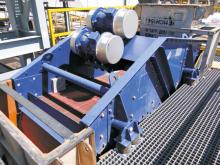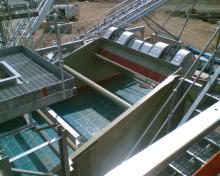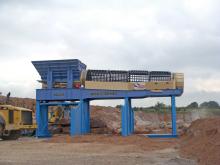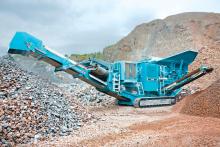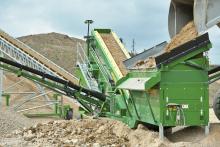
An aggregates production comminution circuit is only as efficient as the weakest link in the chain, and in many cases the majority of the links along this chain are screens.
They perform a sizing and separation function at three crucial stages of the process: taking the raw run-of-quarry mixture and preparing it for crushing or washing; separating these products into the final, saleable product, and removing water from products to allow efficient transportation.
The throughput of the whole comminution process depends on the efficiency of the screens, and if they are not carefully selected and regularly monitored for performance they can easily become a major bottleneck, says Russell Lafford of
As operators look to increase their output, this is driving demand for bigger screens in an effort to get material through the screens at a higher rate. But, whatever the size of the screen and however many tonnes of material are passing over it each hour, it is vital that it continues to operate efficiently. So how is efficiency in a screen defined, and how can it be achieved?
The aim of passing material over a separating screen is to extract particles that are small enough to fit through the slots in the screen medium. It is virtually impossible for any screen to be 100% efficient. If it was, this would mean that every particle in the mixture small enough to fit through the screen would find its way through and, in reality, this is never the Case: some fine particles will always be retained. If a screen is said to be 70% efficient, this means that 30% of the particles small enough to pass through the apertures are being retained with the oversized material.
Achieving high efficiency in separation depends on the level of stratification that is achieved in the bed of material on the screen or, in other words, the ease with which small particles can find their way between the larger rocks in the feed down towards the screen medium itself.
The factors that determine how readily this occurs are the speed and direction of the vibration applied to the mixture and the angle of inclination of the screen. Where the correct level of stratification is achieved, the depth of the bed will decrease gradually from the feed end to the discharge end, as the finer material falls out of the mixture.
The depth of the bed of material is one of the easiest ways to identify whether the screen is functioning correctly: too deep, and not enough fine material will find its way down to the screen medium. Typically, the industry standard is to aim for the depth of the bed at the discharge end to be no greater than four times the size of the apertures in the screen medium.
Overloaded screens are all too common a sight at aggregates production plants and the result is a loss of screening efficiency. A great deal of fine material will inevitably be carried over the screen, leading to a product that is not properly separated.
There are a number of ways to decrease the bed depth of an overloaded screen. Of course, the most obvious is to reduce the rate of loading, although naturally this will directly reduce the throughput and is not always an option.
Increasing the speed at which the screen vibrates can speed up stratification and reduce the depth of the bed, but there is a trade-off, as speeding up the oscillation will reduce the life of the bearings within the exciters, calling for increased maintenance. The amplitude of the vibration also needs careful consideration. While it can improve stratification, too much travel can cause finer material to bounce along the screen, reducing the probability of it finding its way through an aperture.
In general, separating out coarser particles calls for greater amplitude and lower frequencies while finer particles prefer the opposite.
The angle at which the screen is inclined is another key parameter. The steeper the incline, the faster the rate at which material travels over it. Generally speaking this is desirable, as long as the speed doesn’t become so rapid that fine material does not have chance to escape before reaching the discharge.
For many applications, varying the incline along the deck can deliver impressive results in terms of increasing travel speeds without compromising on separation efficiency. As a result, these units (known as banana screens) are rapidly gaining popularity in higher throughput applications.
The final consideration is the size of the apertures in the screen medium, and it is important to bear in mind that a proportion of the fine particles will always be retained in the oversize output. For this reason, the appropriate slot size to deliver a mixture of a given specification might be slightly larger than the actual separation grade required.
When it comes to dewatering screens, the aim is to retain as much of the solid material as possible while discarding the maximum amount of water. Here, a much lower rate of stratification is desirable, as this reduces the proportion of material lost through the slots in the screen medium.
Typically the aim with a dewatering screen is for around 85% of the particles that are smaller than the apertures to be retained in the mixture. This is achieved by encouraging a much deeper bed of material on the screen by ensuring a steep positive incline, with material held behind a discharge weir.
There is no getting away from the fact that screens are relatively high-maintenance pieces of equipment, and the main reasons for this are the effects of pegging and blinding. The first occurs when particles of a similar size to the apertures become lodged and the second is caused by a build-up of very fine particles and water around the slots. Both impede particles passing through the medium, reducing the efficiency.
While some technologies exist to try to combat these effects, such as a layer of rubber balls beneath the medium to try to clear pegged particles, or heating elements to remove moisture, really there is no substitute for regular monitoring and maintenance in ensuring efficiency is maintained.
Regular replacement of the screen medium is also important as high levels of impact with abrasive materials quickly wears away the apertures, affecting the separation specification.
The right tool for the job
In achieving efficient screening that will deliver products of the right specification at the maximum rate of throughput, it is vital to understand the dynamics of the material passing over the screen.
There is certainly no one-size-fits-all solution. Before a manufacturer can supply a screen that will meet production targets, they will need detailed information on production tonnage, the type of material, the shape and size of the particles that make it up, whether the feed is delivered in a slurry and, if so, what the concentration is. Even practical concerns such as the size and shape of the space available for the installation can have a significant bearing on the choice.
Most quality manufacturers will be happy to visit sites and consult to ensure the correct product is specified, and this exercise can be well worth the time.
Indeed,
The 900mm feed material is made up of existing waste material, stockpiled over many years, and newly-blasted stone with problematic fines, especially during wet weather periods. Other methods of screening have been tried in the past but were found to be unsuccessful.
Recovery rates in excess of 60% have been reported with the Hercules.
“The customer operates a number of quarries in Germany and the HT182M was found to be suitable due to its quick and easy installation during movements between sites as project requirements change. The diesel power-pack is ideal for the customer as there is no mains electricity in the working areas at the quarry face,” says Stelex.
The power-pack allows the barrel rotation speed and feeder stroke rate to be changed very quickly and easily to suit the feed material characteristics and the weather conditions at different locations and at different times of the year.
The trommel is producing a fines material and a clean gabian-sized material under the trommel (now a new sellable product for the operator giving added financial benefits) plus a clean oversized stone from the end of the 8m long barrel. The -76mm fines can be re-screened to recover further sizes as required.
The clean oversize can be re-crushed at other locations in the existing plant, a process made more efficient as there is no contamination within it that could cause extra problems to the crushers.
Terex Finlay has introduced its new 893 tracked mobile heavy-duty screener with the capacity to process at a rate of up to 800tonnes/hour after being fed by a tracked mobile crusher or an excavator.
Its forward-facing inclined modular configuration screen box has a 6.1m x 1.83m top deck and a 5.5m x 1.83m bottom deck, and depending on the working application of the machine, hydraulic adjustment can be used to vary the working range angle of the screen box between 14 –18°. The screen box top deck can be fitted with a variety of screening media, including mesh, punch plate, bofor bars and tines, while the bottom deck can be fitted with mesh, punch plate and cascade fingers.
The machine is powered by either a Tier 3/Stage 3A
“The heavy-duty crawler tracks, and optional radio remote control unit, make on site mobility very easy,” says
A key feature of the machine is the ability to hydraulically raise the screen box 600mm at the discharge end to provide additional clearance for ease of media change as well as routine maintenance of the screen box and fines transfer.
Playing an increasingly vital role in the production of accurately sized material has been the WR modular screening media system from
Use of the WR screening media ensures that operational downtime is minimised, due principally to the long lasting rubber and polyurethane materials used to make the screen panels, thereby extending the service intervals. Additionally, the WR screen panels possess a built-in cross beam protection lip which, together with support bar rubber capping, protects the adapter system against wear.
Replacing the screen panels, when the need arises, is easily accomplished because the wedge locking them into place may be quickly removed and reinstalled.
The initial installation of the WR screening media at the quarry took two days. In effect this was a retrofit where the previous screen was removed, and replaced by the modular media, on the existing VFS42/18-2 screen.
The requirement was to enable the Hällevadsholm quarry to produce a 0-16mm product off the second screen deck, but be able to further adjust separation when needed, depending on production demands.
Due to the success of the WR media Skanska Hällevadsholm has further adjusted the production flow with the quarry now also using the media for washing 16-22mm aggregate to be used as macadam, with 1,500-1,600tonnes of crushed rock now passing through the screen on a daily basis.
Smiley Monroe’s new ZipClip system
UK and India-based endless conveyor belts manufacturer,
The innovative product, which the company says , which the company says is the fastest, safest and securest installation method in the market, is the latest addition to Smiley Monroe’s aftermarket offering for the mobile crushing, screening and recycling sector.
Available in flat and chevron belt widths up to 1,400mm, in belt thicknesses from 5mm to 18mm, ZipClip’s plates and staples are manufactured from stainless chromium steel and spring steel to resist corrosion and the connecting pin is a stainless chromium-nickel cable with a highly wear resistant steel armour wrap and threaded end.
Ideal for smaller pulleys, ZipClip’s hinged arrangement is greased to increase the lifetime of the pin and is sealed with polyurethane to minimise sifting of fines.
Tim Monroe, Smiley Monroe’s marketing manager said: “Once fitted, ZipClip belts can be run immediately and unlike other splice methods, no special training or expensive equipment is required by operators. Even environmental conditions, such as high humidity, dust, sand or extreme cold will not adversely affect splicing.”
Smiley Monroe’s ZipClip system is already in operation around the world, in demanding applications such as aggregates, hard rock quarrying, recycling and demolition, peat harvesting and biomass, where it is becoming increasingly popular for replacing conveyor belts in remote locations without power or beyond the reach of splice crews.
Smiley Monroe recommends that customers stock spare ZipClip belts for their hardest working belts, which are factory prepared and supplied ready-to-fit to the exact specification and endless length. A hand brace or power tool for inserting the pin and pulling-on piece to suit belt width are sold separately. Online product support includes ‘how to’ videos and every belt is shipped with easy-to-follow instructions.

